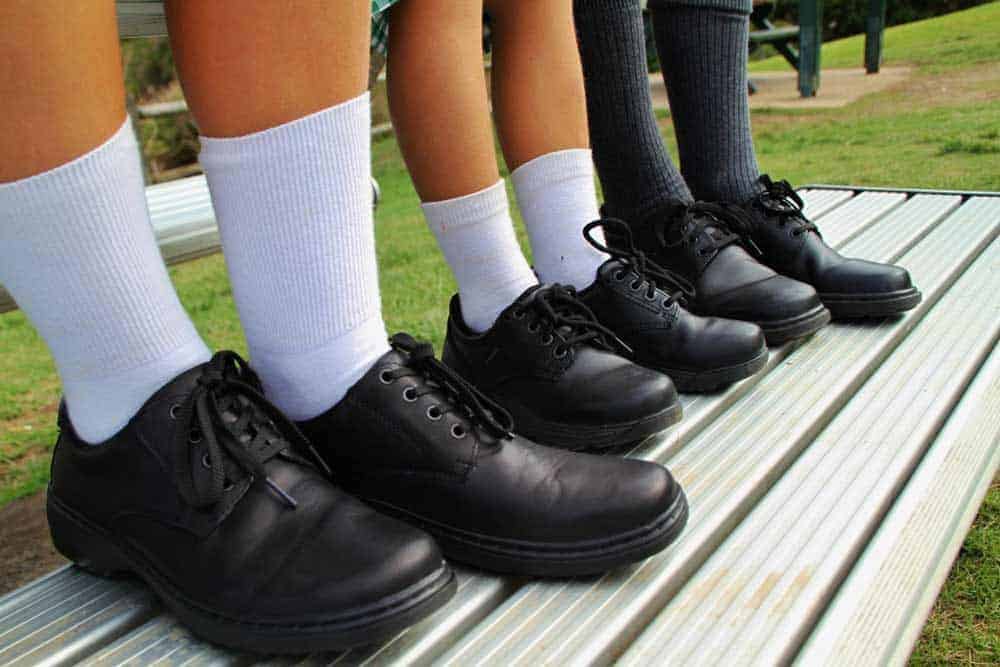
Blog, Kids Feet

Kids Feet
Pain (usually described as aching, throbbing or cramping) in the thighs, calves, behind the knee of one or both legs, or in the feet that occurs in the evening or night. These are the typical symptoms of ‘growing pains’. However, despite the name—there’s no evidence that growing is painful.
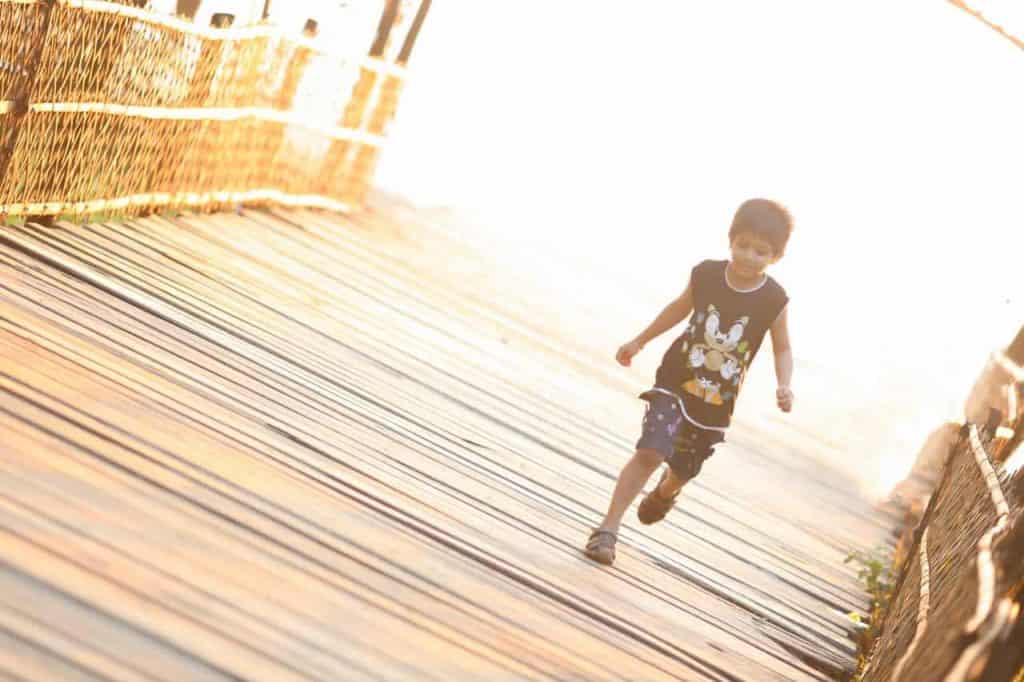
Growing pains and what you can do about them
So what is causing your child’s pain?
Muscle overuse during the day is a likely cause of musculoskeletal pain at night. Muscle overuse can be caused by simple and common activities such as running, jumping, climbing or even standing for lengthy periods.
Common symptoms of activity-based musculoskeletal pain include:
- Pain located in the lower limbs
- Pain is isolated to lower limbs (legs, calves, ankles, feet)
- Likely incidence of sport or activity within last 48 hours
- Pain can worsen as child continues activity
- Temporary relief may be achieved with pain relief medication, massage or heat packs
Treating ‘growing pains’
“Children suffering from ‘growing pains’ are commonly told, “they’ll grow out of it” or “just rest” — this advice is not only disappointing and frustrating for parents it is NOT A TREATMENT MODALITY,” says podiatrist and founder of A Step Ahead Foot + Ankle Care Dr Brenden Brown.
If the discomfort is linked to activity-based musculoskeletal pain, there are a myriad treatment options including:
- Foot posture assessment
- Soft tissue rehab therapy
- Warm-up and training modifications
- Progressive muscle loading
- Prescription orthotics (ideally soft and pliable)
“The answer to ‘growing pains’ is that you don’t need to wait until your child outgrows the pain. The pain experienced is treatable with the right assessment and approach,” advises Dr Brenden.
A Step Ahead Foot + Ankle Care is based in Western Sydney. We have multiple practitioners with lots of experience in helping kids become pain free.
If you’d like more information please contact our helpful front desk team. They are brilliant at working through what help you need, guiding you to the appointment that is right for you or your family, running through cost and then reserving your appointment time. Call us today on +61 2 9673 2987 we look forward to helping.
Got a question about growing pains, musculoskeletal pain or any other foot or ankle concern? Visit us on Instagram #AskDrFoot @AstepAheadFootandAnkleCare or Facebook @podiatristsydney
Related articles:
Growing pains—more than just pain from growing
Taking care of common kids’ foot complaints
Heels pain in active kids (Sever’s disease)
Infographic: Common kids’ heel pain

Heel Pain, Kids Feet, Uncategorized
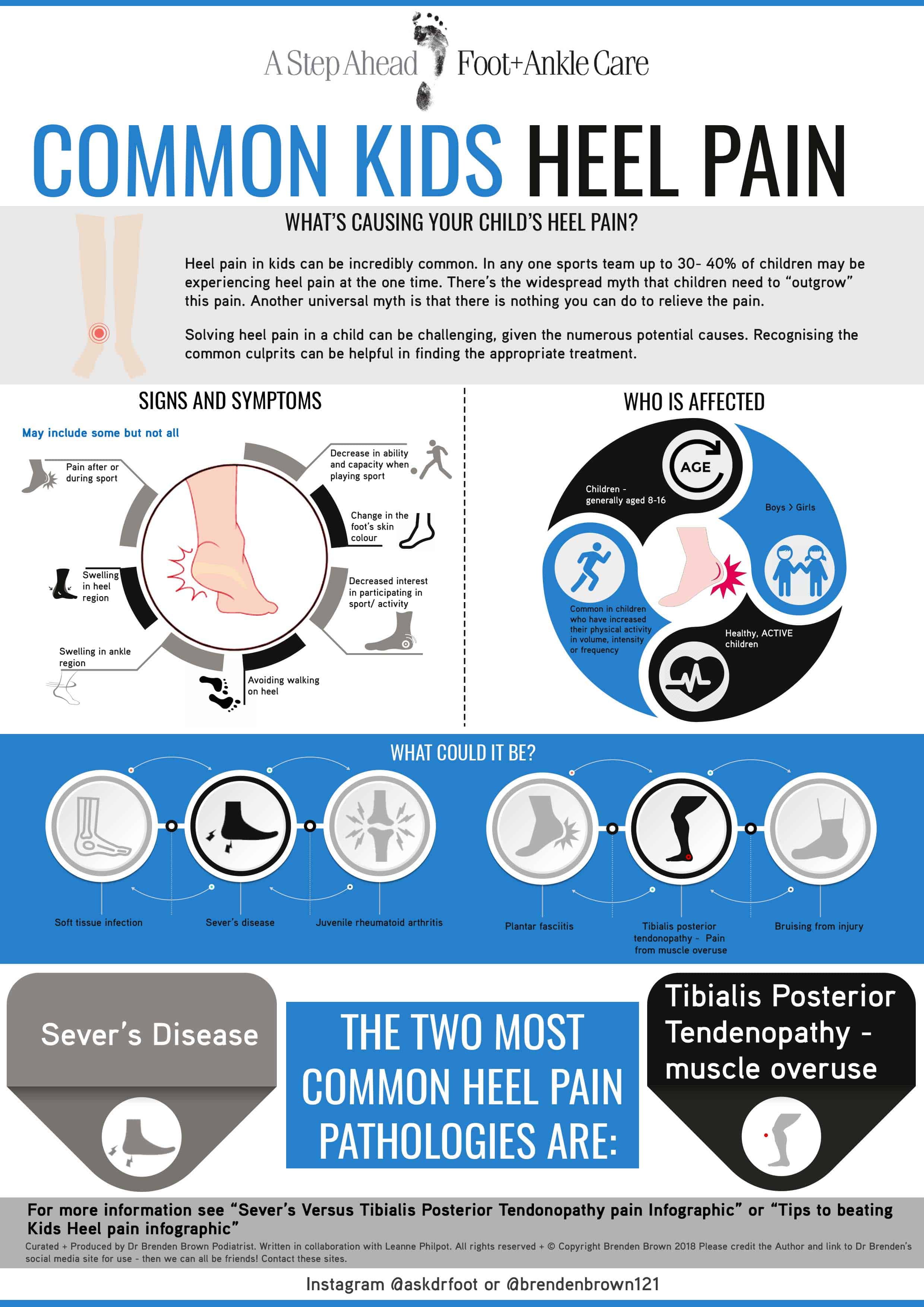
INFOGRAPHIC: Common kids’ heel pain
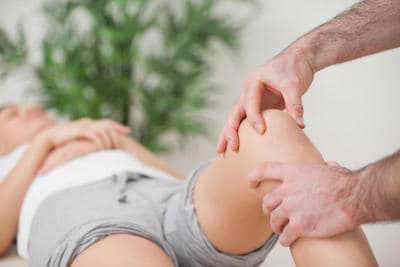
Blog, Kids Feet
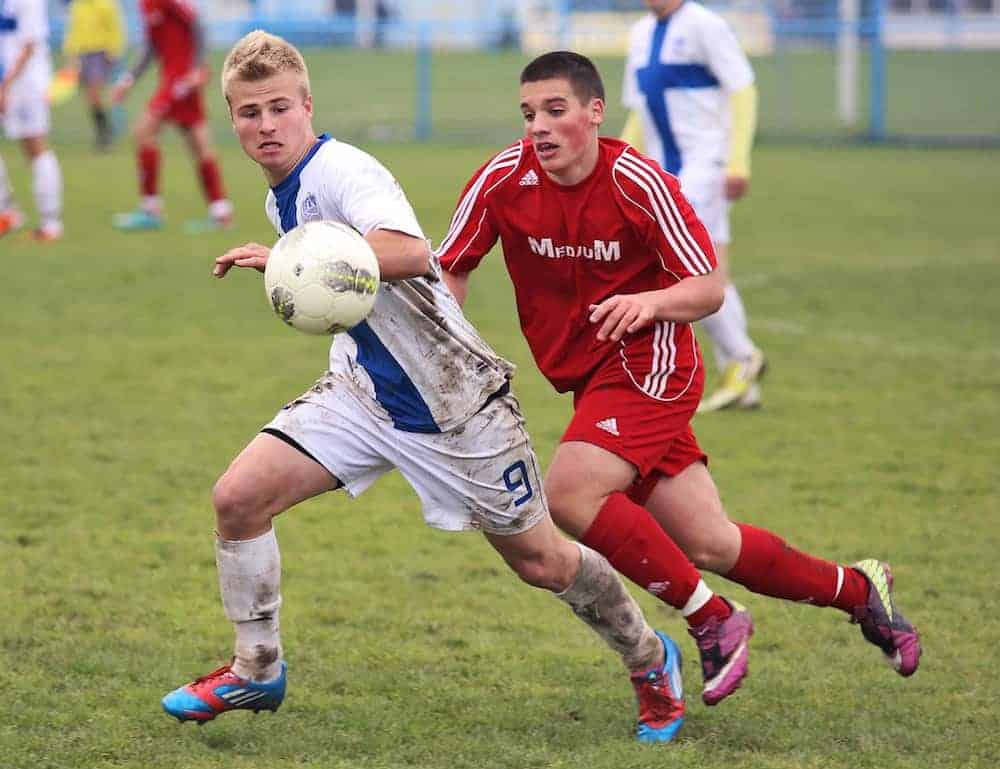
Knee pain in kids
“Knee pain almost exclusively only affects active kids,” says sports podiatrist and founder of A Step Ahead Foot + Ankle Care Dr Brenden Brown.
“In the majority of cases the knee pain will be related to a specific period of activity.
“Sometimes you have to look back 12 hours before the pain starts to pinpoint the activity that caused it. For example, a child might be sore and suffering from a really painful knee on Sunday yet because they didn’t hobble off the footy field after their game on Saturday the parents don’t relate the pain to playing football.”
Causes of kids’ knee pain
Dr Brenden says knee pain in children is predominantly caused by Osgood-Schlatter disease.
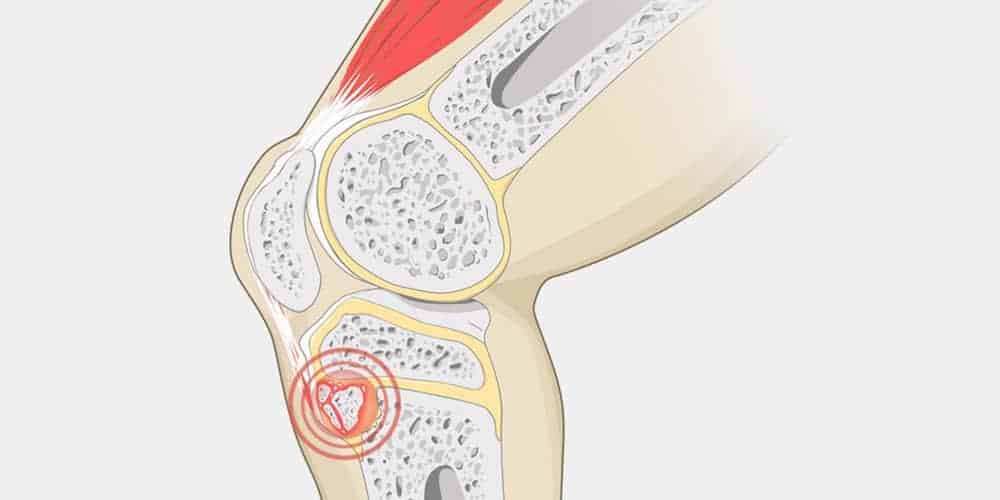
What is Osgood-Schlatter disease?
Osgood-Schlatter disease is characterised by a painful lump just below the kneecap.
According to the American Academy of Orthopaedic Surgeons, ‘Osgood-Schlatter disease most often occurs during growth spurts, when bones, muscles, tendons, and other structures are changing rapidly. Because physical activity puts additional stress on bones and muscles, children who participate in athletics—especially running and jumping sports—are at an increased risk for this condition. However, less active adolescents may also experience this problem.’
Treating knee pain in kids
“The most common treatment approach by practitioners is stretching or advising the child to stop playing sport.
“I disagree,” says Dr Brenden.
“Telling kids to stop playing sport is not a treatment modality. It’s simply avoiding the cause of the pain. Once they start activity again, BOOM the pain re-appears!
“Similarly, stretching alone will not, in most cases, cure the underlying problem. I see children who are given stretching routines by their healthcare professionals time and time again, season after season. If knee pain is an ongoing problem for the child, we should be evaluating their foot posture in order to find the core problem and a positive long-term solution.”
Dr Brenden adds, “There are far too many viable treatment options available which can address the underlying issue of knee pain and keep children active.
“Advising a child to stop playing sport is no longer necessary and is in fact detrimental to child’s long-term health”
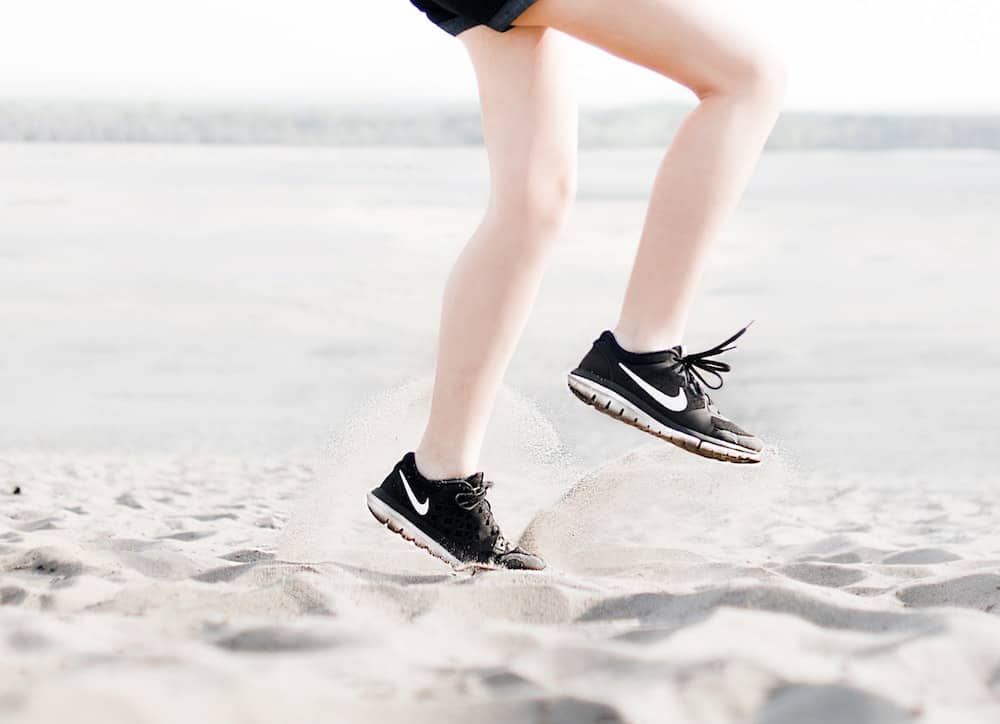
Tips to prevent knee pain in kids
—Warm up properly. Before you “warm up” with a jog, try walking at a moderate to brisk pace 4 times around the football field (8 times around a netball court). Start slow, increase as you progress—NEVER run!
—Ensuring you’re wearing the right footwear can help protect the knees. Wear good, supportive, sports-specific shoes (not the trendiest runners you can find!).
“Choosing appropriate footwear that’s specific to the sport being played would likely reduce the amount of foot-related injuries we see by at least 25%,” says Dr Brenden.
—Work on improving the leg muscle strength and flexibility. Isometric strength exercises are readily accessible and can be performed anywhere—even when in pain!
Related articles:
Warming up for sports…why bother?
What’s causing your child’s heel pain?
Common kids’ foot complaints
ABOUT US
A Step Ahead Foot + Ankle Care is one of Sydney’s leading foot and ankle clinics. Principal podiatrist and founder of A Step Ahead Dr Brenden Brown (AKA Dr Foot) has been taking care of people’s feet for more than 20 years.
With a background in sports medicine and having served as a former president of the Australasian Podiatry Council, Brenden is a wealth of information when it comes to foot and ankle care.
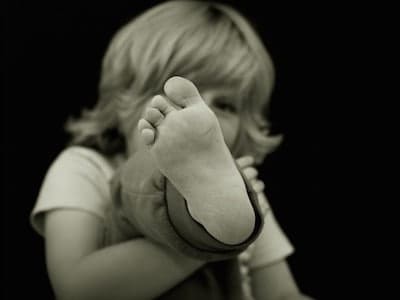
Blog, Heel Pain, Kids Feet
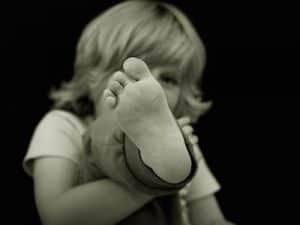
What’s causing your child’s heel pain?
Heel pain in kids is incredibly common. In fact, kids’ sports teams can have up to 30 or 40% of children experiencing heel pain at any one time.
“The greatest incidence of heel pain in children is generally seen in those aged 8-16, who have increased their physical activity in volume, intensity or frequency,” says sports podiatrist and founder of A Step Ahead Foot + Ankle Care Dr Brenden Brown.
Causes of heel pain
There’s a myriad causes of heel pain from soft tissue infection and Sever’s disease to juvenile rheumatoid arthritis, plantar fasciitis and tibialis posterior tendonopathy (muscle overuse).
The question is, what’s causing your kid’s heel pain?
“Two of the most common causes of heel pain are Sever’s disease and tibialis posterior tendonopathy,” says Dr Brenden.
“However, many coaches and healthcare practitioners mistakenly over-diagnose childhood heel pain for Sever’s disease—when the underlying cause is tibialis posterior tendonopathy.”
Sever’s disease and tibialis posterior tendonopathy often share common areas of pain and overlapping symptoms. Yet, unless properly diagnosed treatment will be incorrect and may lead to ongoing pain.
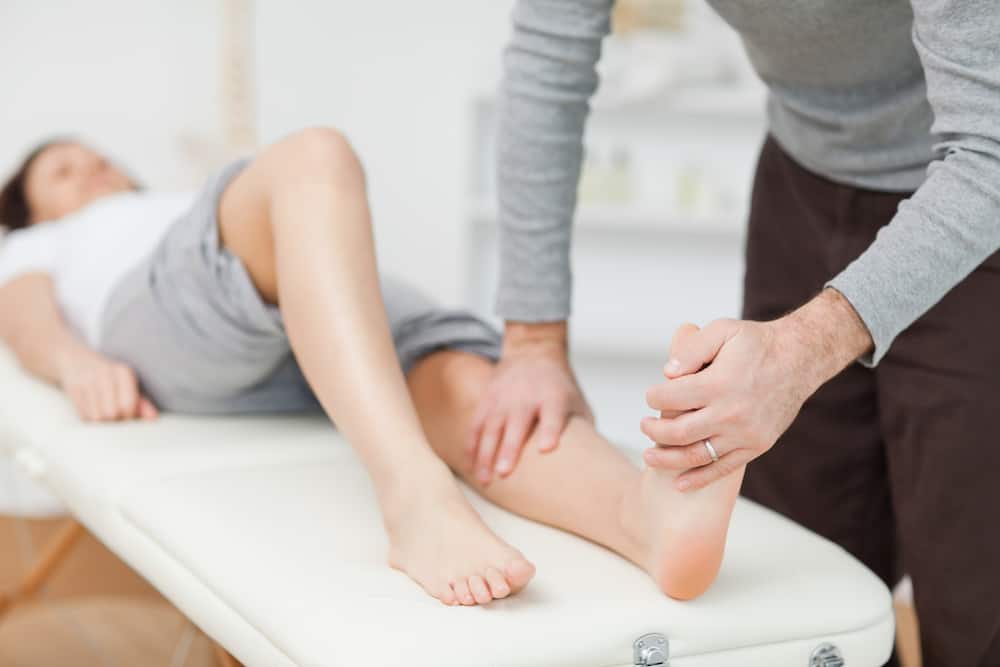
Sever’s disease
“Although more of a repetitive strain injury than an actual disease—Sever’s disease (known medically as a self-limiting calcaneal apophysitis!) is a result of irritation, stress and inflammation of the growth plate (centre) of the heel bone,” explains Dr Brenden.
Causes of Sever’s disease can include:
- Rapidly or recently increasing physical activity in volume, intensity or frequency
- Doing sports in bare feet
- Excessive walking in thongs
- Poor foot posture (flat feet)
- Weak foot muscles
Symptoms of Sever’s disease include:
- Pain and stiffness in the heel
- Heel pain after sport
- Swelling on the heel, which may be sore to touch
- Limping
- Tiptoeing to avoid heel contact with the floor
Tibialis posterior tendonopathy
“Tibialis posterior tendonopathy is a common overuse injury, which may occur due to sudden increases and changes in sports training. It’s a result of the muscles overworking in an attempt to roll the foot and ankle outwards.
“People with over-pronation (often recognised as a flattening or rolling in of the foot) can experience the symptoms of tibialis posterior tendonopathy as a result of the muscles overworking to correct poor foot posture,” says Dr Brenden.
Causes of tibialis posterior tendonopathy can include:
- Poor foot posture (Flat feet is the most common cause)
- Rapid or recent increases in volume, intensity or frequency of physical activity
- Completing sport in bare feet
- Walking excessively in thongs
- Poor footwear choices
- Weak foot muscles
Tibialis posterior tendonopathy symptoms include:
- Pain and stiffness located around inside of ankle
- Heel pain after sport
- Swelling of inside of ankle
- Pain during and after sport
- Pain sometimes confused with “growing pains”
Sever’s vs tibialis posterior tendonopathy (TPT)
While the causes of Sever’s disease and tibialis posterior tendonopathy are similar, there are some key differences to differentiate them.
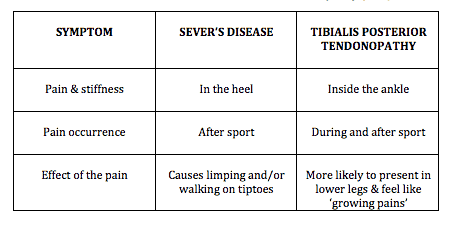
THE GOOD NEWS: both Sever’s disease and tibialis posterior tendonopathy pain have successful treatment protocols.
If your child is suffering from heel pain it’s important to have their feet professionally checked to identify the ‘actual’ cause of their heel pain and start them off on the correct treatment path.
Treatments include deep massage, strengthening protocols, stretching, footwear recommendations and orthoses should foot posture issues be present.
Related articles:
Think you have a heel spur? Think again
10 things you should know about heel pain
In the media: Dr Brenden Brown talking heel pain
Want to know more about taking care of kids’ feet? Visit: mykidsfootdoctor.com.au.
A Step Ahead Foot + Ankle Care is one of Sydney’s leading foot and ankle clinics. Principal podiatrist and founder of A Step Ahead Dr Brenden Brown (AKA Dr Foot) has been taking care of people’s feet for more than 20 years.
With a background in sports medicine and having served as a former president of the Australasian Podiatry Council, Brenden is a wealth of information when it comes to foot and ankle care.
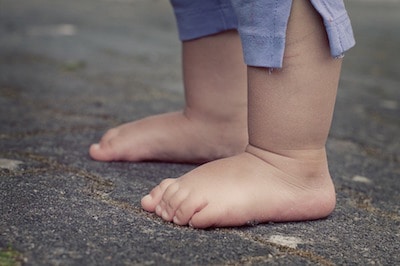
Blog, Kids Feet, Uncategorized

Taking care of common kids’ foot complaints
While most parents worry about the health of their child’s eyes and teeth, many overlook the state of their kids’ feet. Feet are amazing; not only do they enable us to stand tall and move, they support our body weight and act as shock absorbers, in turn protecting our ankles, knees, hips and spine.
In young children the foot is pliable to allow it to develop, which means taking care of feet during the first few years of a child’s life is vital.
Recognising common foot complaints can help ensure that action is taken to address the problem and ensure your child’s feet continue to develop in a healthy way.

Ingrown toenails
Ingrown toenails are common with multiple causes. Widespread causes can include clipping the nails too short, cutting or picking at the edges of the nail, trauma to the nail due to kicking sports, excessively sweaty feet and pressure from footwear. All of these events can create a sharp edge on the nail, which can pierce the skin and lead to an ingrown toenail.
The symptoms of an ingrown toenail (onychocrytosis) can include a sore toe, pain at one side of the toenail and, in severe cases, a pus-filled discharge. In most cases it’s usually the big toe that’s affected.
Closed-toe shoes are likely to increase the intensity of the pain and, if left untreated, it’s common for the toenail to become infected making it difficult to walk and particularly painful to play sport.
To treat an ingrown toenail start by soaking the foot daily in warm, salty water, gently patting dry and applying a topical antiseptic. If possible, refrain from wearing enclosed shoes.
If the issue does not resolve within a couple of days it may require treatment by a podiatrist. This is a simple procedure that involves removing the small, sharp portion of nail causing the grief and dressing the nail to protect against infection. It usually takes minutes.
In acute cases nail surgery may be required.

Flat feet
In infants flat feet is common because they have a fat pad under the foot that hides the developing arch. By about the age of eight, the foot arch becomes apparent. Yet some children never develop an arch and this is called ‘flat feet’.
Flat feet or pronated feet (foot and ankle roll inwards) can be hereditary or due to muscle length and tone. In some instances the condition causes no pain or discomfort but in other cases flat feet or over pronated feet can cause pain in multiple areas of the body including the foot itself, shins, knees, lower back and Achilles tendons.
A podiatrist can help treat flat feet using orthotics, which hold the feet in their correct position and help relieve the associated pain. A detailed biomechanical analysis is conducted to diagnose which type of orthotics is best (there are many!).
In addition to orthotics, a podiatrist can advise on other measures that can be taken as part of a multi-pronged treatment plan. This may include stretching, strengthening exercises or deep connective tissue massage. Bare in mind that being overweight or wearing poor footwear can contribute to the symptoms of flat feet.
Plantar warts
Warts can be the bane of a parent’s life because they are so easy to contract, yet notoriously difficult to get rid of.
Often mistaken for corns, plantar warts appear as small (less than 5mm) rough, flat bumps on the bottom of the foot—usually on the underside of the toes, heel or forefoot. Some plantar warts have little black dots in the centre. This is caused by small blood vessels.
Warts are the result of a virus, so they are easily transferred to other children and adults and are particularly common in swimming pools, gyms, communal showers and other places that involve water, warmth and bare feet.
There’s a plethora of treatments for plantar warts but many are lengthy and not always successful. If over-the-counter non-prescription medicines don’t work, you can try a prescription medication such as salicylic acid or cryotherapy, which involves freezing the wart with liquid nitrogen.
Alternatively, your local podiatrist can use laser treatment or a small instrument to remove the wart. To prevent future plantar warts, avoid letting your child go barefoot in high-risk places such as public showers and outdoor swimming pools.
Want to know more about taking care of kids’ feet? Visit: mykidsfootdoctor.com.au.
Got a question? Ask Dr Foot
A Step Ahead Foot + Ankle Care is one of Sydney’s leading foot and ankle clinics. Principal podiatrist and founder of A Step Ahead Dr Brenden Brown (AKA Dr Foot) has been taking care of people’s feet for more than 20 years. With a background in sports medicine and having served as a former president of the Australasian Podiatry Council, Brenden is a wealth of information when it comes to foot and ankle care.
Related blogs:
Does your child need to see a podiatrist?
Are growing pains causing your child discomfort?

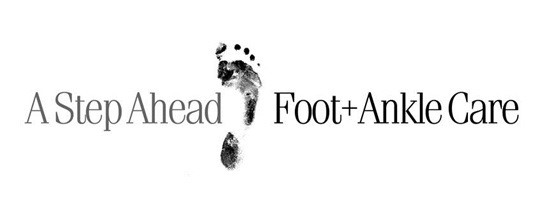




















 Dr Brenden’s White paper report on the “6 Reasons You Won’t Beat Heal Pain” outlines what’s stopping you from beating this and tips on how to stop it in its tracks!
Dr Brenden’s White paper report on the “6 Reasons You Won’t Beat Heal Pain” outlines what’s stopping you from beating this and tips on how to stop it in its tracks!